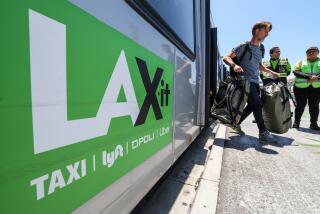Bus Lines Stop Short of Destinations and Expectations
- Share via
Ever try to get around this county by bus? It’s not easy.
Apparently, this place isn’t quite big enough to justify a full-fledged bus line. We get by on a hodgepodge of SCATs, VISTAs, CATs and a few other bus, trolley and train lines. But if you really want to get from Ojai to Simi Valley, you might consider buying a car.
Of course, transit lines lose big money everywhere, so it’s always hard to justify the expense. In Ventura County, fares account for only 24% of the cost of operation, said Peter Drake, general manager of the South Coast Area Transit line. The rest comes from subsidies, most of them sales tax revenues generated by the Transit Development Act of 1971.
Funny thing, though: A lot of people go to war over all this, because in this county, the money is divided between transit lines and road maintenance departments. To these guys, the annual dash for cash is a matter of survival.
And cash--or transportation officials’ attempts to allocate it in the most sensible way--is the key to our first letter this week.
Dear Street Smart:
On a recent Sunday, I wanted to travel to Channel Islands Harbor from the Ventura Keys area. I decided to take the bus and save on gasoline. I figured I would be doing my part to cut down on pollution by choosing mass transit.
Imagine my surprise to find that I would have to take a circuitous route on two different buses and that would only get me into south Oxnard, from where I would have to take a cab to get to the harbor.
I thought there would be a direct line down Harbor Boulevard because Channel Islands Harbor is such a nice spot and so many people live there. Why doesn’t this area have bus service?
Is this the situation throughout Ventura County? It seems to me a county of this size should have better bus service.
Could you give me some idea of what services are available for public transit?
Janice Duncan, Ventura
*
Dear Reader:
We went to Drake for the answer to this, and found that there is no service down our coastline.
“What?” we said, in a stunned tone.
“No bus down our beautiful coastline? How can this be?”
Well, Drake pointed out, there really isn’t anybody living on that coastline. There are a few pockets, including Oxnard Shores, and those people simply have no bus service.
Other than that, you have a stretch of harbor notable only for an Edison Co. power plant, a go-cart track and a sewer treatment plant, the latter of which creates little demand for a bus stop.
Anyway, as Duncan found out, she would have to take a serpentine path that involved at least two buses and a trek through south Oxnard.
If the county grows as some people fear it will, there will probably be pressure for a bigger, more integrated bus line.
The county’s system includes SCAT, which is jointly run by the county and the cities of Ojai, Oxnard, Ventura and Port Hueneme. Camarillo has its own service, called CAT, for Camarillo Area Transit. A dial-a-ride service links residents up to SCAT, which is linked to bus services in Thousand Oaks and other areas by the county’s VISTA, a.k.a. the Ventura Intercity Service Transit Authority.
SCAT fares are $1 for adults, 75 cents for students and 50 cents for people over 65 and the disabled. It’s free for children under 5 and adults over 75.
There is also a $2 SCAT access minivan for the disabled and seniors, along with other services, such as the Ojai Trolley and the dial-a-ride in Santa Paula. SCAT carries 3 million passengers a year on 13 routes with a 46-bus fleet, 35 of them natural-gas powered.
Drake says he expects to see some increase as the county puts welfare-to-work programs into effect.
As for the money-losing nature of the services, Drake says there are important reasons to support transit anyway.
“It’s for the individuals who are transit-dependent, who don’t have access to automobiles,” he said. “We’re providing a service to folks who otherwise have no opportunity.”
Drake may be fighting a losing battle if history is a precedent in transit matters.
The first line in county history, a horse-drawn trolley car that ran on rails down Main Street, ended near the turn of the century when someone pushed it into the ocean off Seaward Avenue. Soon after, the rails disappeared as Main Street’s dirt was turned to pavement.
****
Dear Street Smart:
My wife and I are visiting Ventura while it snows back home. We were walking around the downtown area when we saw some signs for a trolley, which sounded like a great way for us to get around and get to know the town.
But we have yet to see the trolley itself. Does it only run in summer?
Gary Pickford, Duluth, Minn.
*
Dear Reader:
First of all, welcome to sunny, friendly Ventura. This ain’t one of them uppity, crowded joints, like Newport Beach, where nasty surfers yell “Go home!” to tourists.
However, I must tell you that the trolley is no more. Perhaps it was doomed, like dive bars in a redevelopment zone.
The bright green-and-orange buses used to make hourly loops between downtown, Ventura Harbor and Seaside Park, but the service ended last Labor Day. Apparently the 25-cent fare wasn’t quite enough to keep it rolling--providing only about $2,000 of the $50,000 annual cost. The line was supposed to be financed by advertising revenue, but that never materialized.
So the city and its trolley partners--local tourism-oriented firms and a private company, Ventura County Shuttle and Airporter--shut it down.
But take heart. If you visit us in summertime, you might see it rolling again.
City officials hope to bring the trolley back, if they can work out a firmer deal for the ad bucks, said Everett Millais, the city’s director of community services.
“We’re trying to revive it,” he said.
If it does return, it will probably reappear sometime in March and operate only in summer.
So, Gary, why not come on back? I hear it’s kinda humid in Duluth in the summer.
More to Read
Sign up for Essential California
The most important California stories and recommendations in your inbox every morning.
You may occasionally receive promotional content from the Los Angeles Times.










